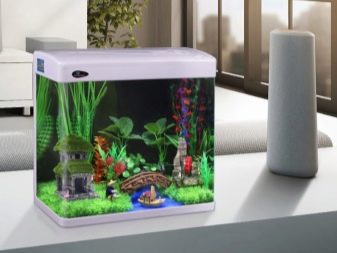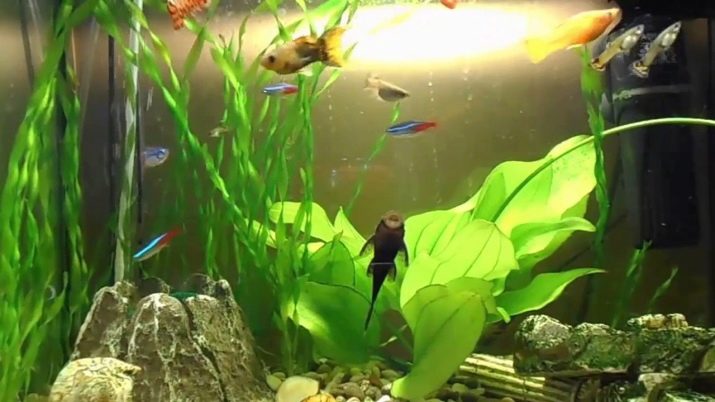Mini-aquariums: how to equip and what kind of fish to get?

Novice amateur aquarists often hesitate to purchase a large aquarium right away, but want to try their hand at breeding fish and other representatives of the underwater kingdom. A good way out of the situation in this case are compact versions of such tanks. But even a mini-aquarium requires care and creation of a comfortable environment for the life of pets. It is necessary to study in advance all the features of its maintenance, purchase the necessary equipment.
What kind of fish to have in a tiny aquarium? Do you need snails or other inhabitants of the underwater world? Which lamps are suitable for a small aquarium and which are not? The answers to these questions will help you to properly prepare for the exciting new role of the owner of a full-fledged, albeit small, underwater world.

Advantages and disadvantages
The decision to have a mini aquarium at home has its advantages and disadvantages. A tiny tank will not allow you to have many fish, in addition, it will be more difficult to monitor and care for the created biological system than in the case of a large tank. Here, much more frequent water changes will be required, and its parameters will have to be carefully monitored. But otherwise, such an acquisition has more advantages than disadvantages.
Among the advantages that a mini-aquarium has, it can be noted:
- simplicity and ease of placement;
- minimum costs for the arrangement;
- light weight - it can be carried and serviced without assistance;
- the possibility of acquiring small fish, invisible in a large container;
- simplification of control over the condition of the inhabitants;
- unlimited possibilities for decoration and arrangement.

Equipment selection
When creating an environment for keeping future pets, you should make sure that the fish are comfortable. It is worth considering that any square or rectangular tank suits the inhabitants of the underwater world much more than a bank or a rounded container that distorts the vision of the world. A miniature aquarium needs to be equipped with protective glass, installed away from drafts, contact with direct sunlight.
It is important to consider that a small reservoir will require more frequent cleaning, it is more difficult to maintain optimal water parameters in it.
It will be impossible to do without additional life support systems. The higher the density of the aquarium population, the more intensively you will have to monitor the purity and quality of the water.

From the equipment, you will have to purchase the same kit that is required for the full-size version. Among the necessary components:
- filter or pump with aerator;
- a heater, it is better to immediately choose an automatic one, with a thermostat;
- carbon dioxide supply system;
- Lightning equipment.
If you have no experience and special knowledge at all, you can purchase a nano aquarium with a completely ready-made set of equipment. But it will be much more useful to independently gain experience in choosing the right components. Pumps with or without a small sponge are not suitable for use in a tank containing fish. In this case, a much more productive technique is required with a throughput of 8-15 standard aquarium volumes per hour. It is important that the filter does not create a strong flow of water.

An important requirement is the presence of protection against the ingress of small inhabitants of the aquatic environment into the filtration system. The optimal model is compact, collapsible, with a convenient flushing system, in harmony with the landscape. This category includes indoor filters with open sponges or hinged outdoor waterfall systems. A canister model is also suitable, but the intake pipe here will have to be supplemented with a mesh or sponge. An interesting solution can be a phyto filter, in which live plants are added to the waterfall, absorbing harmful substances.
Small aquariums may require additional accessories to make life easier for the fish breeder. So, it is worth taking care of buying a special thermometer fixed on the wall of the tank to measure the temperature of the water. Another useful tool is the soil siphon, which allows you to completely remove any dirt from your aquarium. You will need a scraper to clean the walls of the container, and a landing net for transferring pets.

Lighting features
Typically, mini-aquariums up to 40 liters in volume are sold with lighting already installed. But if you equip the tank yourself, you will have to spend time selecting and installing a lamp of the required type. Among the features of nanoaquariums, one can note the installation of the backlight not on the lid of the container, but above it at a certain distance. As a source of illumination, fluorescent lamps are used with a power calculation of 0.5 W per liter for unpretentious plants and 1 W for ground cover and some other types of flora. For LED backlighting, this indicator is measured in lumens - from 25 to 50 lumens per liter.
You can't do without artificial lighting - most fish require much longer daylight hours than are found in Russian latitudes. Plus, even plants need extra lighting.
When choosing equipment, it is very important not to exceed the recommended light intensity. Otherwise, there will be a great risk that the water will turn into a favorable breeding ground for the active reproduction of algae.

Selection of fish and plants
The first thing that begins with arranging and populating a mini-aquarium is the selection and planting of plants. To create the best conditions inside the tank, it is imperative to take care of the supply of CO2, sufficient lighting brightness, high-quality soil with an organic component.In this case, for planting, you can choose any dwarf and just low plants. If the aquarium is equipped with less suitable living conditions, it is better to do with unpretentious, slowly growing representatives of the flora kingdom.
Having live plants is highly desirable for a small aquarium. They provide the conditions for maintaining biological balance in the closed space of the reservoir. In a mini-aquarium, plants remove excess carbon dioxide and nitrates from the water, provide oxygen supply, and act as an additional source of food for the fish.

Among the ground cover plants, Marsilia, Brazilian Lileopsis, and Hemianthus Cuba are considered suitable for miniature reservoirs. Japanese is not suitable for landing blix. Despite its status as a ground cover plant, it looks like a large bush in a small container and takes up too much space.
Among other plants for a mini-aquarium, you can use ferns, anubias, cryptocorynes, rotals, pogostemons. For planting on the surfaces of stones and snags, mosses are used. If the area allows, you can get cladophores. With enough imagination, you can create an unusual and very beautiful composition in the aquarium. The decoration of miniature tanks is often compared to the art of bonsai - so spectacular can be created underwater compositions.


The smallest fish can be populated into a mini-aquarium - no more than 3-4 cm in length, and if the capacity is up to 15 liters, then even up to 2-3 cm. The content of predators is excluded, all pets should be peaceful, without pronounced territorial attachment. According to the degree of gluttony, you also need to select pets with approximately equal, moderate appetites. Bright colors and a high level of physical activity will also be a big advantage.
A fairly large number of fish meet these requirements. The most unpretentious, and at the same time, interesting for novice aquarists are representatives of the carp family. Among the recommended fish, the micro-collection galaxy with an incredible body coloration stands out. Interesting and unpretentious in keeping zebrafish, boraras.

Characin fish are also handy pets. Among the spawning subspecies, the tetra of amanda and neons can be distinguished. Viviparous fish can be represented by platies and guppies. To maintain cleanliness in the aquarium, it is worth having catfish of ototsinkluses or corridor pygmies. They are suitable for settling in a miniature tank of cockerels, but it is not recommended to keep them in flocks due to their pugnacious behavior.
The standard stocking density is no more than 1 individual per 2 liters of water. 3-4 individuals of each species will be enough.
In addition, small shrimps or dwarf species of crayfish, hymenochirus frogs can be added to the number of inhabitants of the nanoaquarium. But do not exceed the stocking density too much, otherwise the state of the environment in the container will be unsuitable for keeping fish.

For information on how many fish can be put into an aquarium from 5 to 40 liters, see the next video.








